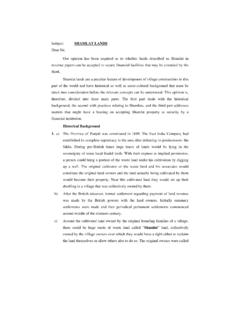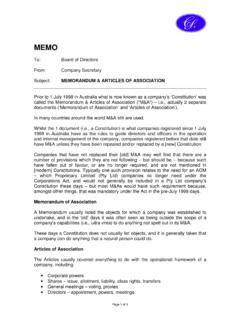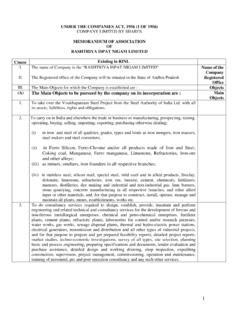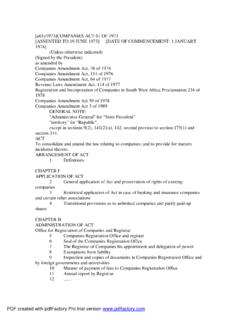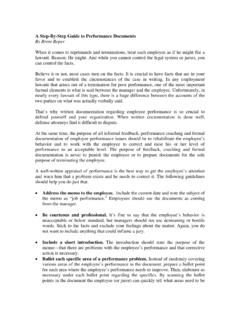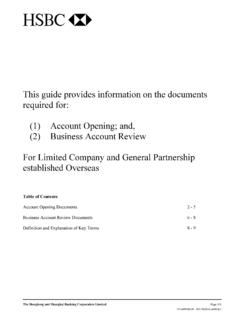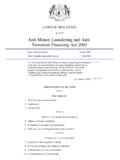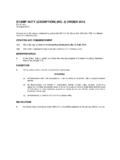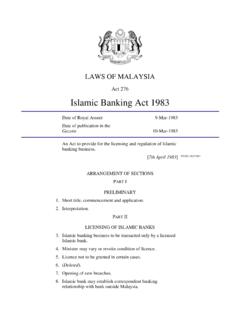Transcription of I have carefully considered the matter and my opinion is ...
1 1. My opinion has been sought as to whether it is necessary that the common seal of a company must be affixed on contracts, board resolutions, etc of a private/public limited company and whether in absence of the common seal the company would still be bound by a document that is being pressed against the company. 2. I have carefully considered the matter and my opinion is as follows: a) Before the issue raised above is discussed, it might be useful to reproduce certain provisions of the Companies Ordinance, 1984 relating to common seal of a company. i) Section 32(2) From the date of incorporation mentioned in the certificate of incorporation, the subscribers of the memorandum , together with such other persons as may from time to time become member of the company, shall be a body corporate by the name contained in the memorandum , capable forthwith of exercising all the functions of an incorporated company, and having perpetual succession and a common seal , but with such liability on the part of the members to contribute to the assets of the company in the event of its being wound up as is mentioned in this Ordinance.
2 Ii) Section 51. Authentication of documents and proceedings. Save as expressly provided in this Ordinance, a document or proceeding requiring authentication by a company may be signed by the chief executive or a director, secretary or other authorised officer of the company, and need not be under its common seal . iii) S. 143 Publication of name by a limited Every limited (a) .. (b) shall have its name engraven in legible English or Urdu characters on its seal . S. 144(2) If an officer of a limited company, or any person on its behalf, uses or authorizes the use of any seal purporting to be a seal of the company wherein its name is not so engraven as aforesaid .. he shall be liable to be a fine which may extend to two thousand rupees. iv) Section 210. Form of contract. (1) Contracts on behalf of a company may be made as follows, that is to say.
3 A) any contract which, if made between private persons, would be by law required to be in writing, signed by the parties to be charged therewith, may be made on behalf of the company in writing signed by any person acting under its authority, express or implied, and may in the same manner be varied or discharged; b) any contract which, if made between private persons, would by law be valid although made by parol only, and not reduced into writing may be made by parol on behalf of the company by any person acting under its authority, express or implied, and may in the same manner be varied or discharged. (2) All contracts made according to sub-section (1) shall be effectual in law and shall bind the company and its successors and all other parties thereto, their heirs, or legal representatives as the case may be.
4 V) Section 211. Bills of exchange and promissory A bill of exchange, hundi or promissory note shall be deemed to have been made, drawn, accepted or endorsed on behalf of a company, if made, drawn, accepted or endorsed in the name of, or by or on behalf or on account of, the company by any person acting under its authority, express or implied. vi) Section 212. Execution of deeds. A company may, by writing under its common seal , empower any person, either generally or in respect of any specified matters as its attorney, to execute deeds on its behalf in any place either in or outside Pakistan; and every deed signed by such attorney, on behalf of the company, and under his seal , where sealing is required, shall bind the company, and have the same effect as if it were under its common seal .
5 B) Although the exact language may vary from case to case, very often the articles of association of a company contain a clause worded, somewhat, as follows: The directors shall provide for the safe custody of the seal and the seal shall not be affixed to any instrument except by the authority of a resolution of the board of directors or by a committee of directors authorized in that behalf by the directors and in the presence of at least two directors and of the secretary or such other person as the directors may appoint for the purpose; and those two directors and secretary or other person and secretary as aforesaid shall sign every instrument to which the seal of the company is so affixed in their presence . c) The judgments of the superior courts on the subject lay down the following principles: i) No document on behalf of a company requires affixation of a seal as a matter of necessity unless A) There is a law which requires that in order to bind the company, the document must be executed under its common seal , or B) It is laid down in the memorandum of association and articles of the company that certain transactions, in order to bind the company, must be under its common seal , or C) It is stated in the resolution of the board of directors or the general meeting that certain transactions, authorized under the resolution, must be under the common seal .
6 Ii) I may point out here that the judgments of courts of law state that even where a seal has been affixed improperly or it has not been affixed where it was required, if a company has had the benefit of a contract, it cannot turn around later on and state that it was not bound since the common seal had not been affixed. d) It may be noted that the common seal practically serves the purpose of being a very useful security device. Since the seal ordinarily has to be affixed in presence of at least two directors or other designated persons, it is possible for a company, if it wants to be sure that execution of certain contracts is properly controlled, to require that they must be executed by affixation of the common seal . Such requirement would ensure that at least two directors or other authorized persons are witness to the transaction and that they are able to ensure that the company is not tied up in unwanted obligations.
7 E) The general conclusions that emerge are - i) A company must have a common seal . ii) The common seal has to be engraven. A rubber stamp or some other printed device cannot be a substitute for the company seal . iii) A company has the power to prescribe that certain transaction must be under its common seal . iv) A common seal can be affixed only in the manner authorized by the constitution of the company. v) Affixation of a common seal without authority carries statutory penalties and may also create personal obligations for those who use the common seal in an unauthorized manner. vi) Affixation of a common seal is required only where it is so stipulated in law, the constitution of a company or in the relevant resolution of the company. f) In the light of the above discussion, it emerges that a company would be bound by all contracts provided they have been executed by a person authorized in accordance with its articles or a resolution of the company.
8 However, where a law, or any other document binding a company, requires that certain transactions must be under the common seal , the company seal must be affixed on the relevant documents and seal must be affixed in the prescribed manner. g) Unless the articles of association of a company so require, a company seal is neither required to be affixed on a Board Resolution nor on a Promissory Note. However, it should only be ensured that the documents have been signed by a person authorized to execute the documents. A should specifically state that it has been executed for and on behalf of the company. As regards board resolution, it may be attested as a true copy by the Chief Executive or a Director or a Secretary of the Company. There is no need for an embossed seal on account forms or applications for finance.
9
